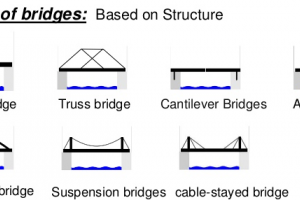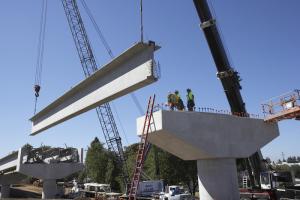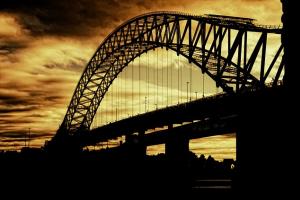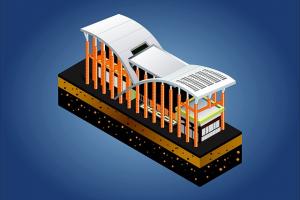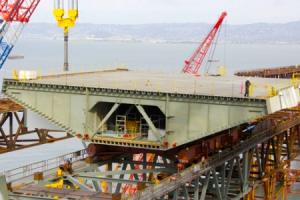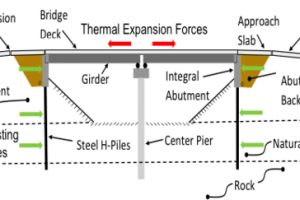How to Design a Bridge - Steps in Bridge Designing
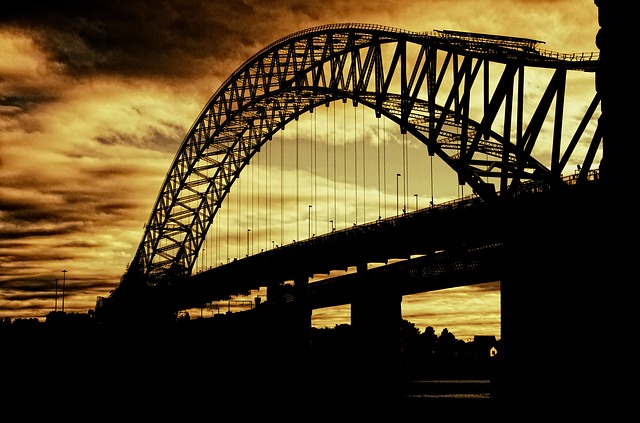
Bridge Designing Video Tutorials
Bridge Designing
The designer should have first seen and studied many bridges in the course of a long learning process in order to design a bridge. He should know what type of beam may be suitable in the available conditions, either a beam bridge an arch bridge or a suspended one. He should also know the influence of foundation conditions on the choice of spans and structural systems etc. hence, the designer of the bridge should not only be a learned person but also an experienced one. At auspicious moments an intuitive flash may provide a new solution, which fulfills the task better than known conventional solutions (intuition, creativity leading to innovations).
Download and Watch Megastructures Videos
Data needed for designing a bridge:
- A plan of the site showing all obstacles to be bridged such as rivers, streets, roads or railroads, the contour lines of valleys and the desired alignment of the new traffic route.
- Longitudinal section of the ground along the axis of the planned bridge with the conditions for clearances or required flood widths. Desired vertical alignment of the new route.
- Required width of the bridge, width of lanes, median, walkways, safety rails etc.
- Soil conditions for foundations, results of borings with a report on the geological situation and soil mechanics data. The degree of difficulty of foundation work has a considerable influence on the choice of the structural system and on the economical span length.
- Local conditions like accessibility for the transport of equipment, materials and structural elements. Which materials are available and economical in that part of the country? Is water or electric power at hand? Can a high standard of technology be used or must the bridge be built with primitive methods and a small number of skilled laborers?
- Weather and environmental conditions, floods, high and low tide levels, periods of drought, range of temperatures, and length of frost periods.
- Topography of the environment - open land, flat or mountainous land, scenic country. Town with small old houses or city with high rise buildings. The scale of the environment has an influence on the design.
- Environmental requirements regarding aesthetic quality. Bridges in towns that affect the urban environment and that are frequently seen at close range - especially pedestrian bridges - need more delicate shaping and treatment than bridges in open country. Is protection of pedestrians against spray and noise needed? Is noise protection necessary for houses close to the bridge?
The designer should visit the bridge site and its environment.
Rough sketch of bridge design:
When the engineer is sure that a design idea has emerged in his mind, he should pick up a pencil and a scale and by the help of sketching, learned at school, he should start from sketching the probable road direction, beam depth(For beam bridge) the piers, the abutments and the bottom edge of the beam is drawn.
For a heavily funded project, high slenderness ratio is preferable otherwise if the decisive factor is the cost then slenderness ratio can be reduced. Analyze the sketch critically for the proportion between the spans, the clearance under the beam, soil conditions around the piers and the abutments, the adaptiveness of the piers to the surroundings, no. of piers and for the curvature of the vertical alignment. More than one sketches may follow after the critical analysis with changes in the design and supporting conditions. Work out the alternatives, discuss with colleagues, architects advisors and the client to draw out a final sketch.
Only now should calculations begin, and in the first place with simple and rough approximations to check whether the assumed dimensions will be sufficient and whether the necessary sectional areas of reinforcing steel or of pre-stressing tendons will leave sufficient space, to allow the concrete to be placed and compacted without difficulty. Then some runs with computer programs can be made, using different depths or other variables in order to find the most economical dimensions; these should, however, only be chosen if no other essential requirements, such as aesthetics, length of approaches, grades etc. are affected.
Once the designer or the design team has made its choice, then the principle design drawings with all dimensions and explanations can be drawn up for approval of the authorities. As the map alone is not sufficient to clearly show the locality and impact on the environment and appearance so a model or some well shot photos can help the citizens, client and critics to realize the existence of bridge.
Finalizing the bridge design:
After the approval of the design, the final design work can begin with rigorous calculations of forces, stresses etc. for all kinds of loads or attacks and then the structural detailing has to be done. The scaffolding and equipment, which will be needed for the construction of the particular type of bridge, also has to be worked out. Numerous drawings and tables with thousands of numbers and figures for all dimensions, sizes and levels must be made with specifications for the required type and quality of the building materials. This phase entails the greatest amount of work for the bridge engineer, and calls for considerable knowledge and skill.
The phase of conceptual and aesthetic design needs a comparatively small amount of time, but is decisive for the expressive quality of the work.
Bridge Design Learning Course Contents
Introduction
- Bridge History
- Definition
Types of Bridges
- Beam/Arch
- Truss
- Suspension
- Cable Stayed
Statical Systems of Bridges
- How bridge works
- Load Transfer in Beam bridges
- Load transfer in Arch and truss bridges
- Load transfer for suspension and cable stayed bridges
- Loads transfer for cantliver bridges
Bridge Elements
- Main Elements of the bridge
- Types of spans
- Super structure vs sub structure
- Substructure part 1: Pier
- Substructure part 2 - Abutments
- Bridge Superstructure
Design methodology of bridges
- Main design methods
- Load resistance
- ASD , LFD , LRFD methods
Design loads of bridges
- Different loads affecting on the bridge
- DEAD LOADS
- LIVE LOADS
- LIVE LOAD CALCULATION , INFLUENCE LINE
- Pedestrian live loads and Dynamic allowance factor
- Multiple presence factor
- Distribution of LL through the girders
- wind and earthquake loads
- LRFD Load combination explanation



